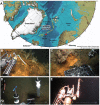Distribution Patterns of Iron-Oxidizing Zeta- and Beta-Proteobacteria From Different Environmental Settings at the Jan Mayen Vent Fields
- PMID: 30574135
- PMCID: PMC6292416
- DOI: 10.3389/fmicb.2018.03008
Distribution Patterns of Iron-Oxidizing Zeta- and Beta-Proteobacteria From Different Environmental Settings at the Jan Mayen Vent Fields
Abstract
Iron oxidizers are widespread in marine environments and play an important role in marine iron cycling. However, little is known about the overall distribution of iron oxidizers within hydrothermal systems, including settings with little hydrothermal activity. Moreover, the extent to which different phylogenetic groups of iron oxidizers exhibit niche specialization toward different environmental settings, remains largely unknown. Obtaining such knowledge is critical to unraveling the impact of the activity of iron oxidizers and how they are adapted. Here, we used 16S rRNA sequencing to characterize the distribution of iron oxidizers in different environmental settings within the Jan Mayen hydrothermal vent fields (JMVFs). Putative iron oxidizers affiliated to Zetaproteobacteria and Betaproteobacteria were detected within iron mounds, bottom seawater, basalt surfaces, and surface layers of sediments. The detected iron oxidizers were compared to sequence types previously observed in patchily distributed iron mats associated with diffuse venting at the JMVFs. Most OTUs of iron oxidizers reoccurred under different environmental settings, suggesting a limited degree of niche specialization. Consequently, most of the detected iron oxidizers seem to be generalists with a large habitat range. Our study highlights the importance of gathering information about the overall distribution of iron oxidizers in hydrothermal systems to fully understand the role of this metabolic group regarding cycling of iron. Furthermore, our results provide further evidence of the presence of iron-oxidizing members of Betaproteobacteria in marine environments.
Keywords: Betaproteobacteria; Zetaproteobacteria; hydrothermal systems; iron oxidizers; microbial ecology.
Figures





Similar articles
-
Validating the Cyc2 Neutrophilic Iron Oxidation Pathway Using Meta-omics of Zetaproteobacteria Iron Mats at Marine Hydrothermal Vents.mSystems. 2020 Feb 18;5(1):e00553-19. doi: 10.1128/mSystems.00553-19. mSystems. 2020. PMID: 32071158 Free PMC article.
-
Microbial iron mats at the Mid-Atlantic Ridge and evidence that Zetaproteobacteria may be restricted to iron-oxidizing marine systems.PLoS One. 2015 Mar 11;10(3):e0119284. doi: 10.1371/journal.pone.0119284. eCollection 2015. PLoS One. 2015. PMID: 25760332 Free PMC article.
-
Microaerophilic Fe(II)-Oxidizing Zetaproteobacteria Isolated from Low-Fe Marine Coastal Sediments: Physiology and Composition of Their Twisted Stalks.Appl Environ Microbiol. 2017 Mar 31;83(8):e03118-16. doi: 10.1128/AEM.03118-16. Print 2017 Apr 15. Appl Environ Microbiol. 2017. PMID: 28159791 Free PMC article.
-
The iron-oxidizing proteobacteria.Microbiology (Reading). 2011 Jun;157(Pt 6):1551-1564. doi: 10.1099/mic.0.045344-0. Epub 2011 Apr 21. Microbiology (Reading). 2011. PMID: 21511765 Review.
-
Iron-oxidizing bacteria in marine environments: recent progresses and future directions.World J Microbiol Biotechnol. 2018 Jul 4;34(8):110. doi: 10.1007/s11274-018-2491-y. World J Microbiol Biotechnol. 2018. PMID: 29974320 Review.
Cited by
-
Putative novel hydrogen- and iron-oxidizing sheath-producing Zetaproteobacteria thrive at the Fåvne deep-sea hydrothermal vent field.mSystems. 2023 Dec 21;8(6):e0054323. doi: 10.1128/msystems.00543-23. Epub 2023 Nov 3. mSystems. 2023. PMID: 37921472 Free PMC article.
-
Metagenomics survey unravels diversity of biogas microbiomes with potential to enhance productivity in Kenya.PLoS One. 2021 Jan 4;16(1):e0244755. doi: 10.1371/journal.pone.0244755. eCollection 2021. PLoS One. 2021. PMID: 33395690 Free PMC article.
-
Validating the Cyc2 Neutrophilic Iron Oxidation Pathway Using Meta-omics of Zetaproteobacteria Iron Mats at Marine Hydrothermal Vents.mSystems. 2020 Feb 18;5(1):e00553-19. doi: 10.1128/mSystems.00553-19. mSystems. 2020. PMID: 32071158 Free PMC article.
-
Linking Zetaproteobacterial diversity and substratum type in iron-rich microbial mats from the Lucky Strike hydrothermal field (EMSO-Azores observatory).Appl Environ Microbiol. 2024 Feb 21;90(2):e0204123. doi: 10.1128/aem.02041-23. Epub 2024 Jan 9. Appl Environ Microbiol. 2024. PMID: 38193671 Free PMC article.
References
-
- Crossey L., Karlstrom K., Schmandt B., Crow R., Colman D., Cron B., et al. (2016). Continental smokers couple mantle degassing and distinctive microbiology within continents. Earth Planet. Sci. Lett. 43 22–30. 10.1016/j.epsl.2015.11.039 - DOI
LinkOut - more resources
Full Text Sources

